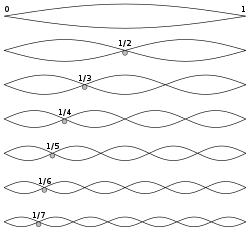Acoustics
Acoustics is the interdisciplinary science that deals with the study of all mechanical waves in gases, liquids, and solids including vibration, sound, ultrasound and infrasound. A scientist who works in the field of acoustics is an acoustician while someone working in the field of acoustics technology may be called an acoustical or audio engineer. The application of acoustics can be seen in almost all aspects of modern society with the most obvious being the audio and noise control industries.
Hearing is one of the most crucial means of survival in the animal world, and speech is one of the most distinctive characteristics of human development and culture. So it is no surprise that the science of acoustics spreads across so many facets of our society—music, medicine, architecture, industrial production, warfare and more. Art, craft, science and technology have provoked one another to advance the whole, as in many other fields of knowledge. Lindsay's 'Wheel of Acoustics' is a well accepted overview of the various fields in acoustics.
The word "acoustic" is derived from the Greek word ἀκουστικός (akoustikos), meaning "of or for hearing, ready to hear" and that from ἀκουστός (akoustos), "heard, audible", which in turn derives from the verb ἀκούω (akouo), "I hear"
The Latin synonym is "sonic", after which the term sonics used to be a synonym for acoustics and later a branch of acoustics After acousticians had extended their studies to frequencies above and below the audible range, it became conventional to identify these frequency ranges as "ultrasonic" and "infrasonic" respectively, while letting the word "acoustic" refer to the entire frequency range without limit.
History of acoustics
Early research in acoustics
The fundamental and the first 6 overtones of a vibrating string. The earliest records of the study of this phenomenon are attributed to the philosopher Pythagoras in the 6th century BC.
In the 6th century BC, the Greek philosopher Pythagoras wanted to know why some intervals seemed more beautiful than others, and he found answers in terms of numerical ratios representing the harmonic overtone series on a string. He is reputed to have observed that when the lengths of vibrating strings are expressible as ratios of integers (e.g. 2 to 3, 3 to 4), the tones produced will be harmonious. If, for example, a string sounds the note C when plucked, a string twice as long will sound the same note an octave lower. The tones in between are then given by 16:9 for D, 8:5 for E, 3:2 for F, 4:3 for G, 6:5 for A, and 16:15 for B, in ascending order.Aristotle (384-322 BC) understood that sound consisted of contractions and expansions of the air "falling upon and striking the air which is next to it...", a very good expression of the nature of wave motion. In about 20 BC, the Roman architect and engineer Vitruvius wrote a treatise on the acoustic properties of theatres including discussion of interference, echoes, and reverberation—the beginnings of architectural acoustics
Principles of acoustics were applied since ancient times : Roman theatre in the city of Amman.
The physical understanding of acoustical processes advanced rapidly during and after the Scientific Revolution. Mainly Galileo Galilei (1564–1642) but also Marin Mersenne (1588–1648), independently, discovered the complete laws of vibrating strings (completing what Pythagoras and Pytagoreans had started 2000 years earlier). Galileo wrote "Waves are produced by the vibrations of a sonorous body, which spread through the air, bringing to the tympanum of the ear a stimulus which the mind interprets as sound", a remarkable statement that points to the beginnings of physiological and psychological acoustics. Experimental measurements of the speed of sound in air were carried out successfully between 1630 and 1680 by a number of investigators, prominently Mersenne. Meanwhile Newton (1642–1727) derived the relationship for wave velocity in solids, a cornerstone of physical acoustics (Principia, 1687).
The Age of Enlightenment and onward
The eighteenth century saw major advances in acoustics as mathematicians applied the new techniques of calculus to elaborate theories of sound wave propagation. In the nineteenth century the major figures of mathematical acoustics were Helmholtz in Germany, who consolidated the field of physiological acoustics, and Lord Rayleigh in England, who combined the previous knowledge with his own copious contributions to the field in his monumental work "The Theory of Sound". Also in the 19th century, Wheatstone, Ohm, and Henry developed the analogy between electricity and acoustics.
The twentieth century saw a burgeoning of technological applications of the large body of scientific knowledge that was by then in place. The first such application was Sabine’s groundbreaking work in architectural acoustics, and many others followed. Underwater acoustics was used for detecting submarines in the first World War. Sound recording and the telephone played important roles in a global transformation of society. Sound measurement and analysis reached new levels of accuracy and sophistication through the use of electronics and computing. The ultrasonic frequency range enabled wholly new kinds of application in medicine and industry. New kinds of transducers (generators and receivers of acoustic energy) were invented and put to use.
Fundamental concepts of acoustics
Jay Pritzker Pavilion
At Jay Pritzker Pavilion, a LARES system is combined with a zoned sound reinforcement system, both suspended on an overhead steel trellis, to synthesize an indoor acoustic environment outdoors.
The study of acoustics revolves around the generation, propagation and reception of mechanical waves and vibrations.
The fundamental acoustical process
The steps shown in the above diagram can be found in any acoustical event or process. There are many kinds of cause, both natural and volitional. There are many kinds of transduction process that convert energy from some other form into acoustic energy, producing the acoustic wave. There is one fundamental equation that describes acoustic wave propagation, but the phenomena that emerge from it are varied and often complex. The wave carries energy throughout the propagating medium. Eventually this energy is transduced again into other forms, in ways that again may be natural and/or volitionally contrived. The final effect may be purely physical or it may reach far into the biological or volitional domains. The five basic steps are found equally well whether we are talking about an earthquake, a submarine using sonar to locate its foe, or a band playing in a rock concert.
The central stage in the acoustical process is wave propagation. This falls within the domain of physical acoustics. In fluids, sound propagates primarily as a pressure wave. In solids, mechanical waves can take many forms including longitudinal waves, transverse waves and surface waves.
Acoustics looks first at the pressure levels and frequencies in the sound wave. Transduction processes are also of special importance.
Wave propagation: pressure levels
Spectrogram of a young girl saying "oh, no"
In fluids such as air and water, sound waves propagate as disturbances in the ambient pressure level. While this disturbance is usually small, it is still noticeable to the human ear. The smallest sound that a person can hear, known as the threshold of hearing, is nine orders of magnitude smaller than the ambient pressure. The loudness of these disturbances is called the sound pressure level (SPL), and is measured on a logarithmic scale in decibels.
Wave propagation: frequency
Physicists and acoustic engineers tend to discuss sound pressure levels in terms of frequencies, partly because this is how our ears interpret sound. What we experience as "higher pitched" or "lower pitched" sounds are pressure vibrations having a higher or lower number of cycles per second. In a common technique of acoustic measurement, acoustic signals are sampled in time, and then presented in more meaningful forms such as octave bands or time frequency plots. Both these popular methods are used to analyze sound and better understand the acoustic phenomenon.
The entire spectrum can be divided into three sections: audio, ultrasonic, and infrasonic. The audio range falls between 20 Hz and 20,000 Hz. This range is important because its frequencies can be detected by the human ear. This range has a number of applications, including speech communication and music. The ultrasonic range refers to the very high frequencies: 20,000 Hz and higher. This range has shorter wavelengths which allows better resolution in imaging technologies. Medical applications such as ultrasonography and elastography rely on the ultrasonic frequency range. On the other end of the spectrum, the lowest frequencies are known as the infrasonic range. These frequencies can be used to study geological phenomena such as earthquakes.
Analytic instruments such as the Spectrum analyzer facilitate visualization and measurement of acoustic signals and their properties. The Spectrogram produced by such an instrument is a graphical display of the time varying pressure level and frequency profiles which give a specific acoustic signal its defining character.
Transduction in acoustics
An inexpensive low fidelity 3.5 inch driver, typically found in small radios
A transducer is a device for converting one form of energy into another. In an acoustical context, this usually means converting sound energy into electrical energy (or vice versa). For nearly all acoustic applications, some type of acoustic transducer is necessary. Acoustic transducers include loudspeakers, microphones, hydrophones and sonar projectors. These devices convert an electric signal to or from a sound pressure wave. The most widely used transduction principles are electromagnetism, electrostatics and piezoelectricity.
The transducers in most common loudspeakers (e.g. woofers and tweeters), are electromagnetic devices and generate waves using a suspended diaphragm driven by an electromagnetic voice coil, sending off pressure waves. Electret microphones and condenser microphones employ electrostatics. As the sound wave strikes the microphone's diaphragm, it moves and induces a voltage change. The ultrasonic systems used in medical ultrasonography employ piezoelectric transducers. These are made from special ceramics in which elastic vibrations and electrical fields are interlinked through a property of the material itself.
Divisions of acoustics
The table below shows seventeen major subfields of acoustics established in the PACS classification system. These have been grouped into three domains: physical acoustics, biological acoustics and acoustical engineering.
Physical acoustics Biological acoustics Acoustical engineering
* Aeroacoustics
* General linear acoustics
* Nonlinear acoustics
* Structural acoustics and vibration
* Underwater sound
* Bioacoustics
* Musical acoustics
* Physiological acoustics
* Psychoacoustics
* Speech communication (production;
perception; processing and communication systems)
* Acoustic measurements and instrumentation
* Acoustic signal processing
* Architectural acoustics
* Environmental acoustics
* Transduction
* Ultrasonics
* Room acoustics



No comments:
Post a Comment